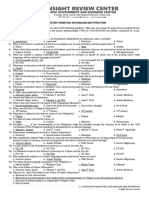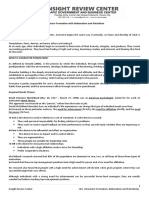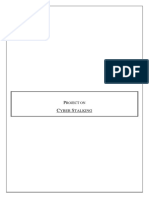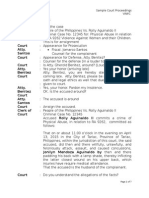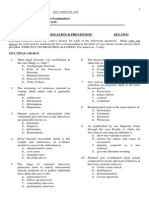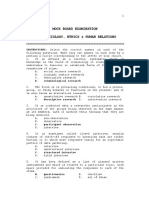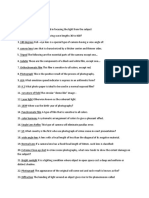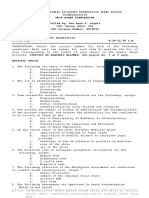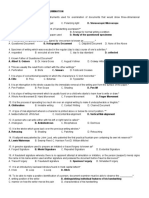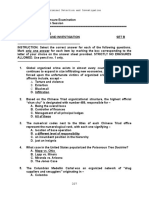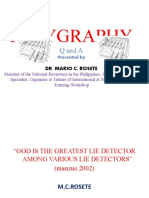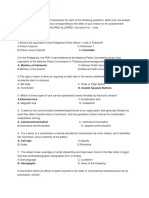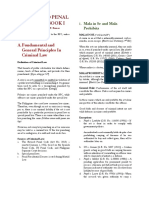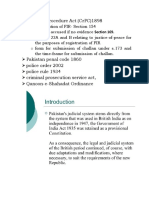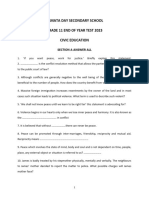Professional Documents
Culture Documents
MCBONES11.crim Investigation and Detection
MCBONES11.crim Investigation and Detection
Uploaded by
criminologyalliance100%(1)100% found this document useful (1 vote)
7K views7 pagesThis document contains a practice exam for a criminology licensure examination. It consists of 42 multiple choice questions testing knowledge of key concepts in criminal investigation and detection. The questions cover topics such as initial crime scene documentation, definitions of legal terms, composite sketching, relevant Philippine laws, chain of custody, crime scene processing procedures, standards of evidence, and investigative techniques such as surveillance and preliminary investigations.
Original Description:
Original Title
MCBONES11.crim investigation and detection
Copyright
© © All Rights Reserved
Available Formats
DOCX, PDF, TXT or read online from Scribd
Share this document
Did you find this document useful?
Is this content inappropriate?
Report this DocumentThis document contains a practice exam for a criminology licensure examination. It consists of 42 multiple choice questions testing knowledge of key concepts in criminal investigation and detection. The questions cover topics such as initial crime scene documentation, definitions of legal terms, composite sketching, relevant Philippine laws, chain of custody, crime scene processing procedures, standards of evidence, and investigative techniques such as surveillance and preliminary investigations.
Copyright:
© All Rights Reserved
Available Formats
Download as DOCX, PDF, TXT or read online from Scribd
Download as docx, pdf, or txt
100%(1)100% found this document useful (1 vote)
7K views7 pagesMCBONES11.crim Investigation and Detection
MCBONES11.crim Investigation and Detection
Uploaded by
criminologyallianceThis document contains a practice exam for a criminology licensure examination. It consists of 42 multiple choice questions testing knowledge of key concepts in criminal investigation and detection. The questions cover topics such as initial crime scene documentation, definitions of legal terms, composite sketching, relevant Philippine laws, chain of custody, crime scene processing procedures, standards of evidence, and investigative techniques such as surveillance and preliminary investigations.
Copyright:
© All Rights Reserved
Available Formats
Download as DOCX, PDF, TXT or read online from Scribd
Download as docx, pdf, or txt
You are on page 1of 7
Prepared by: CYRIL YARAG BUCOG
DIAGNOSTIC EXAMINATION IN
CRIMINAL INVESTIGATION AND DETECTION
CRIMINOLOGISTS Licensure Examination
Second Day 1:30 P.m. – 4:00 p.m.
=================================================================
===
INSTRUCTION: Select the correct answer for each of the following
questions. Mark only one answer for each item by marking the box
corresponding to the letter of your choice on the answer sheet
provided. STRICTLY NO ERASURES ALLOWED. Use pencil no. 1 only.
MULTIPLE CHOICE
1. The written record made by the investigator upon arrival at
the crime scene which contains observations of the crime scene
results of the interview of witnesses, evidence collected and
others is called
a. Initial report c. Investigation report
b. Report d. Field note
2.What is the legal term for nighttime?
a. sanctuary c. absurdity
b. ephitomy d. nocturnity
3. The art of sketching the image of a person by description of
witnesses and victims is called
a. drawing c. composite sketching
b. mapping d. cartooning
4. It is known as the Anti-Human Trafficking Law.
a. RA 9231 c. RA 7438
b. RA 9208 d. RA 8358
5. What law requires the procurement of working permit for minors
to avoid any child exploitation and child abuse in any form?
a. RA 9231 c. RA 7438
b. RA 9208 d. RA 8358
RA 9231 "An Act Providing for the Elimination of the Worst Forms
of Child Labor and Affording Stronger Protection for the Working
Child, Amending for the Purpose R.A. No. 7610."
6. Maintenance made up of all those who had custody of the
evidence since its acquisition by a police agency to ensure
continuous accountability defines
a. chain of custody
b. transfer of evidence
c. custody of evidence d.
chain of custody of evidence
7. Dismembered or cut up parts of the human body such as hand,
feet, torso, sex organ, and others which are thrown to different
places to conceal a crime is called
a. mutilation
b. mutilated remains
c. chop chop
d. mutilated
8. The law on criminal evidence is integrated in the
a. Revised Penal Code
b. Revised Rules of Court
c. 1987 Philippine Constitution
d. Revised Administrative Code
9. An examination of the immediate vicinity of the crime scene
where the perpetrator may have been hiding immediately after
the commission of the crime refers to
a. warm search c. hot search
b. cold search d. none of the above
10. The objective of criminal investigation is to determine the
truth as far as it can be discovered in any post-factum inquiry.
Post-factum means
a. after investigation
b. after an incident
c. before the facts
d. facts of the case
11. If criminal investigation is a process, after identifying
then collecting information and evidences, the next logical step
to do is
a. present them in court
b. preserve their legal integrity
c. evaluate their strength in establishing proof
d. recognize their importance in the case
12. The fundamental responsibility of the officer in charge of
protecting the crime scene is
a. interrogating the witnesses
b. engaging in the search for traces left by the search for
traces left by the criminal
c. removal of evidence which may prone important to the case
d. preserving the site of the crime in the same physical
condition as it was left by the perpetrator
13. Proof beyond reasonable doubt is the weight and sufficiency
of evidence needed to convict the defendant in
a. administrative cases c. civil cases
b. criminal cases d. all of the above
14. A policeman discovers two teenage gangs numbering about 50
boys, engaged in a free-for-all fight. The best immediate course
of action for the policeman to take is to
a. call the police station for reinforcement
b. fire over the heads of the boys (warning shots) and order them
to disperse
c. arrest the ring leaders
d. call upon adult bystanders to assist him in restoring order
e. attempt to stop the fight by using his night stick
15. The simplest and the most effective way of showing actual
measurements and identifying significant items of evidence
in their locations at the scene is
a. reconstruction c. physical reconstruction
b. drawing d. sketching
16. Romeo was accused of having murdered Abdullah a Muslim. The
accused claims that the homicide was committed in self defense.
Of the following, the evidence which best supports Romeo claim is
that
a. Romeo was armed; it is uncertain as to whether Abdullah was
armed
b. Neither Romeo nor Abdullah was not armed
c. Romeo was armed; Abdullah was not armed
d. Romeo and Abdullah were armed
e. Abdullah was armed; Romeo was not.
17. Which among the following stages of investigation involves a
longer time span?
a. Preliminary c. In-depth
b. Secondary d. Concluding
18. These are hints that suggest lines of investigative actions
and information that is valuable in expanding the universe of
suspects, identifying prime suspects and finding the guilty
person. These are called
a. information c. investigative leads
b. corpus delicti d. modus operandi
19. Planned and coordinated legal search conducted to locate
physical evidence at the locus criminis refers to
a. Crime scene search c. Intelligence
b. Instrumentation d. Covert operation
20. The means sanctioned by the rules of law, ascertaining the
truth, respecting a matter of fact is known as
a. physical evidence c. corpus delicti
b. evidence d. associative evidence
21. Materiality of evidence means…
a. it is related
b. it has the tendency in reason to establish the probability or
improbability of fact in issue
c. it is directed to prove a fact
d. not excluded by law
22. Competency of evidence means…
a. it is related
b. it has the tendency in reason to establish the probability or
improbability of fact in issue
c. it is directed to prove a fact
d. not excluded by law
23. If the eyewitness is used to identify the perpetrator, what
identification method has the least element of suggestion on the
part of the investigator?
a. Rogues gallery method
b. Portrait parle
c. Cartography
d. Police line-up
24. During a quarrel on a crowded street of Baguio City, one man
stabs another and flees. A policeman arriving at the scene a
short time later finds the victim unconscious, calls for an
ambulance and orders the crowd to leave. His action was
a. bad; there may have been witnesses to the assault among the
crowd
b. good; it is proper first aid procedure to give an injured
person room and air
c. bad; the assailant is probably among the crowd
d. good; a crowd may destroy needed evidence
e. bad; it is poor public relations for the police to order
people about needlessly.
25. The sketch that gives the picture of the crime scene, and its
immediate environment is called
a. sketch of ground
b. sketch of locality
c. sketch of details
d. sketch of surrounding
26. It implies the deliberate planning of the criminal act before
executing it.
a. treachery c. evident premeditation
b. criminal intent d. alevosia
27. Circumstances pertaining to moral order, which adds disgrace
and obloquy to the material injury caused by the crime
a. cruelty c. alevosia
b. ignominy d. treachery
28. The effectiveness of this tool in investigation depends on
the craft, logic and psychological insight of the initiator in
interpreting the information relevant to the case is called
a. Instrumentation c. information
b. Interrogation d. interview
29. It is the product of either deductive or inductive reasoning
or combination of both approaches that more than a learned guess,
but less than a certainty; however, possesses a very high order
of probability.
a. Physical reconstruction c. hypothesis
b. Mental reconstruction d. rational theory
30. It is the type of reconstruction of crime wherein collected
information is analyzed carefully thereby developing a theory of
the crime.
a. Deductive reasoning
b. Physical reconstruction
c. Inductive reasoning
d. Mental reconstruction
31. It is basically a top-down view of the crime scene where the
walls of the room have been folded down to reveal locations of
evidence. This is
a. Cross Projection
b. Rectangulation
c. Grid
d. Polar
32. The condition and favorable time of the suspect to possibly
execute and commit the crime refers to
a. motive c. timing
b. opportunity d. alibi
33. The peculiar habits of the criminals in committing crimes
make an overview of the criminals’
a. operational method c. operational technique
b. modus operandi d. signature of the crime
34. It is the discreet observation of places, persons, and
vehicles for the purpose of obtaining information concerning the
identities or activities of subjects.
a. Surveillance c. Roping
b. Tailing d. Undercov assignment
35. The initial inquiry by officers to establish facts and
circumstances of a suspected crime and to preserve any evidence
related to the crime is called
a. follow up investigation c. inquest
b. preliminary investigation d. ocular inspection
36. In robbery intent to gain means:
a. Loperande Animus
b. Animus Lucrandi
c. Anemus Loperandi
d. Anemae
37. In the Philippines, breaking and entering into house or
building with felonious intent is known as
a. Burglary c. Larceny
b. Robbery d. Theft
38. A commissioned police officer who effected a raid without
search warrant and justifiable reasons will be considered a case
of
a. Misfeasance c. Nonfeasance
b. Malfeasance d. none of the above
39. What are the chances of two people having the same DNA
"fingerprint"?
a. 4 million to 1
b. 3 billion to 1
c. 30 billion to 1
d. 60 billion to 1
40. Which detective case code reveals that the case was cleared
by arrest?
a. VCI (Victim Cancelled Investigation)
b. COP (Closed, Other Prosecution)
c. PRF (Prosecutor Refused to File)
d. WPA (Warrant Pending Arrest)
41. How many subjects need to stand as possible suspects for a
legal line-up?
a. 5
b. 6
c. 7
d. 8
42. According to the portrait parle of identification, which set
of peculiarities are the most important?
a. age, race, build
b. nose, hair, complexion
c. chin, eyes, lips
d. neck, mouth, ears
43. What is the standard inner perimeter for roping off an
outdoor crime scene?
a. ten square feet
b. twenty square feet
c. forty square feet
d. sixty square feet
44. A law enforcement conversation with witnesses or victims
should follow a ____ pattern.
a. block-by-block
b. signs of the cross
c. you-we-I
d. plain view
45. What kind of sketch would generally be used with an outdoor
crime scene?
a. the coordinate method
b. the triangulation method
c. the cross-projection method
d. the single spiral method
46. The correct order of a crime scene analysis is:
a. sketch, search, photograph
b. search, sketch, photograph
c. photograph, search, sketch
d. photograph, sketch, search
47. The least common man-made fiber is:
a. nylon
b. polyester
c. rayon
d. spandex
48. What does it mean if a person is a "secretor"?
a. they sweat a lot at crime scenes due to a severe perspiration
problem
b. their saliva and other non-blood fluids can be traced to a
blood type
c. their bodily fluids are easily found at crime scenes
d. they leave easy fingerprints to lift because of excessive skin
oil
49. Guilty suspects will usually scratch what part of their body?
a. head
b. neck
c. arms
d. legs
50. If a suspect's eye movement is to their right & up, they are:
a. trying to recall a visual truth
b. trying to make up a visual lie
c. trying to recall an auditory truth
d. trying to make up an auditory lie
51. The cognitive interview technique works best on suspects
with:
a. an alibi
b. memory problems
c. good acting ability
d. psychiatric problems
52. What is the cognitive interviewing technique?
a. eliciting a nonverbal response from the subject
b. eliciting a verbal, emotional response from the subject
c. having the subject repeat the story from various starting
points in the story
d. making the subject feel guilty so they want to confess
53. What method of confronting denial is used on a suspect with
good acting ability and who gives you no nonverbal behavior to
interpret?
a. cognitive interviewing
b. selective interviewing
c. enticement interviewing
d. the Reid model of confession
54. Which of the following is NOT one of the three recognized
types of informants?
a. volunteer
b. paid
c. anonymous
d. conscientious
55. The "instigator"-informant is used most commonly in what
situation?
a case with no leads
b. a buy-bust operation
c. an organized crime case
d. during an ongoing trial to get witnesses
56.The politically correct way to refer to informants is:
a. snitches
b. tipsters
c. junior detectives
d. special employees
57. In a report describing stolen property, which items are first
on the list?
a. articles with market value
b. articles with identifying characteristics
c. articles with numerical characteristics
d. articles bearing initials or personal marks
58. A decomposing body is found in a rural area. The size of the
largest maggot found in the body is 6 millimeters long. How many
days has the victim been dead?
A. 4 days
B. 6 days
C. 8 days
D. 10 days
59. What was the first scientific method of identifying
criminals?
A. fingerprint cards
B. the line-up
C. the Bertillon method
D. the Vucetich-Henry system
60. Visual, fixed surveillance is also known as a:
A. tracer
B. tail
C. tag
D. stakeout
61.Partial rigor mortis (upper body only) has set in. How long
has the victim been dead?
A. 6 hours
B. 12 hours
C. 18 hours
D. 36 hours
You might also like
- Storm Bailey AbuserDocument15 pagesStorm Bailey AbuserCallyNoch keine Bewertungen
- CLJ - Human Rights EducationDocument79 pagesCLJ - Human Rights Educationcriminologyalliance100% (1)
- Dec 2022 QA Character Formation Nationalism and PatriotismDocument4 pagesDec 2022 QA Character Formation Nationalism and PatriotismcriminologyallianceNoch keine Bewertungen
- Dec 2022 Review Notes in Character Formation With Nationalism and PatriotismDocument15 pagesDec 2022 Review Notes in Character Formation With Nationalism and PatriotismcriminologyallianceNoch keine Bewertungen
- 2 Police Personnel and Records ManagementDocument13 pages2 Police Personnel and Records ManagementcriminologyallianceNoch keine Bewertungen
- Comprehensive Examination Law Enforcement Administration 20%Document12 pagesComprehensive Examination Law Enforcement Administration 20%Ranier Factor Aguilar100% (4)
- Exam For Organized Crime Inv.Document18 pagesExam For Organized Crime Inv.Qayes Al-Quqa100% (2)
- Board Questions CriminalisticsDocument14 pagesBoard Questions CriminalisticsAries Gallandez100% (1)
- Mock Board Exam in CDI Set ADocument10 pagesMock Board Exam in CDI Set ALombroso's follower100% (1)
- Crmtcs 2 Compre ExamDocument7 pagesCrmtcs 2 Compre ExamChristopher Pjunatas75% (4)
- Project On Cyber StalkingDocument19 pagesProject On Cyber StalkingKuruvila M JacobNoch keine Bewertungen
- Sample Court ProceedingsDocument7 pagesSample Court ProceedingsJomarco Santos100% (4)
- Cdi Q and A 1Document122 pagesCdi Q and A 1April Delos Reyes TitoNoch keine Bewertungen
- CDI 3 Practice TestDocument103 pagesCDI 3 Practice TestBernel Alegado100% (1)
- CDI Pratice Test Set TWODocument9 pagesCDI Pratice Test Set TWOClarito LopezNoch keine Bewertungen
- Prudence Research & Review Center Baguio City Mock Examination Crime Detection, Investigation & Prevention - Part OneDocument11 pagesPrudence Research & Review Center Baguio City Mock Examination Crime Detection, Investigation & Prevention - Part OneQayes Al-QuqaNoch keine Bewertungen
- Cdi 1 QuestionsDocument10 pagesCdi 1 QuestionsISNANI TATONoch keine Bewertungen
- 2015 Cdi Final CoachingDocument24 pages2015 Cdi Final CoachingJehu Lipata Mensurado100% (1)
- Crime Detection, Investigation & Prevention Sample Board Questionnaires With AnswerDocument23 pagesCrime Detection, Investigation & Prevention Sample Board Questionnaires With AnswerIacomus Bugs86% (7)
- Final Exam KMIADocument10 pagesFinal Exam KMIAAnggayNoch keine Bewertungen
- Mock Board Examination Criminal Sociology, Ethics & Human RelationsDocument14 pagesMock Board Examination Criminal Sociology, Ethics & Human RelationsJayson Castro67% (3)
- POST Test PTROL and Crime Mapping Rank OneDocument5 pagesPOST Test PTROL and Crime Mapping Rank OneRanier Factor AguilarNoch keine Bewertungen
- Mockboard in Crime Detection With AnswersDocument13 pagesMockboard in Crime Detection With AnswersMark Joseph P. Gania100% (1)
- 1 CriminalisticDocument42 pages1 CriminalisticFranzesGanapezValenzuela100% (1)
- Board Exam Questions For Criminologist: Crime Detection, Investigation, and PreventionDocument121 pagesBoard Exam Questions For Criminologist: Crime Detection, Investigation, and PreventionMa Tiffany Cabigon100% (1)
- Quiz No. 8 Special Crime Investigation With Interview and Interrogation Cdi3Document8 pagesQuiz No. 8 Special Crime Investigation With Interview and Interrogation Cdi3lemueljamito19Noch keine Bewertungen
- Review Questions in CdiDocument35 pagesReview Questions in CdiCin DyNoch keine Bewertungen
- KFC Ni Marabella Covid19 InvertedbogokDocument49 pagesKFC Ni Marabella Covid19 InvertedbogokMjay MedinaNoch keine Bewertungen
- Criminal Jurisprudence Reviewer: University of Baguio @FB - Jezreel Vicente (0977-8877-300)Document6 pagesCriminal Jurisprudence Reviewer: University of Baguio @FB - Jezreel Vicente (0977-8877-300)Qayes Al-QuqaNoch keine Bewertungen
- Mockboard Crime Detection and InvestigationDocument10 pagesMockboard Crime Detection and InvestigationEmmanuel BuanNoch keine Bewertungen
- Traffic Management CdiDocument12 pagesTraffic Management CdiLerma PagcaliwanganNoch keine Bewertungen
- LEC 2017 - Post-Test in Comparative Police SystemDocument7 pagesLEC 2017 - Post-Test in Comparative Police SystemBokhary Dimasangkay Manok EliasNoch keine Bewertungen
- Key To Correction For Law Enforcement Operation Planning With Crime MappingDocument12 pagesKey To Correction For Law Enforcement Operation Planning With Crime MappingJoseph Ryche Facunla100% (3)
- Board Questions Crime DetectionDocument39 pagesBoard Questions Crime DetectionAries Gallandez80% (5)
- Correctional-Administration-Questionnaire - QDocument9 pagesCorrectional-Administration-Questionnaire - QRon Niel Ong FusinNoch keine Bewertungen
- Fund. of Crim. Inves.Document70 pagesFund. of Crim. Inves.criminologyalliance100% (1)
- LEA.3 pOLICE PATROLdocxDocument4 pagesLEA.3 pOLICE PATROLdocxRico T. MusongNoch keine Bewertungen
- Cdi-Q ADocument9 pagesCdi-Q Amelbertgutzby vivasNoch keine Bewertungen
- Criminalistics Mock Board Exam 2018Document11 pagesCriminalistics Mock Board Exam 2018Den Mark G. Orquia100% (3)
- Correction 1 QuestionaireDocument6 pagesCorrection 1 QuestionaireFrederick EboñaNoch keine Bewertungen
- CJURIS Q and ADocument763 pagesCJURIS Q and AHarrison sajorNoch keine Bewertungen
- Claw 1 Q and ADocument10 pagesClaw 1 Q and ASkier MishNoch keine Bewertungen
- FRNSC Quiz 3Document3 pagesFRNSC Quiz 3kathleenNoch keine Bewertungen
- rEVIEWER ON CRIM SOCIODocument89 pagesrEVIEWER ON CRIM SOCIOAnton GalloNoch keine Bewertungen
- Crime Detection and InvestigationDocument4 pagesCrime Detection and InvestigationZefren Botilla100% (3)
- Prudence Research & Review Center: Mock Exam in Cdip Subjects Part OneDocument11 pagesPrudence Research & Review Center: Mock Exam in Cdip Subjects Part OneQayes Al-QuqaNoch keine Bewertungen
- CDI 2018 Board ConfidentialDocument18 pagesCDI 2018 Board ConfidentialJohn Mark Manahan50% (2)
- Lea Mock BoardDocument10 pagesLea Mock BoardRenz Dela CruzNoch keine Bewertungen
- CRIMINALISTICSDocument6 pagesCRIMINALISTICSJen Paez100% (1)
- CDIDocument115 pagesCDIJosephine Magbanua100% (1)
- Crime Detection and InvestigationDocument6 pagesCrime Detection and InvestigationJen PaezNoch keine Bewertungen
- Diagnostic Examination in Correctional AdministrationDocument12 pagesDiagnostic Examination in Correctional AdministrationChezca Taberdo100% (3)
- Final Coaching Q and A PolygraphyDocument96 pagesFinal Coaching Q and A PolygraphyLex Tamen Coercitor100% (1)
- Criminology Board Exam ReviewerDocument4 pagesCriminology Board Exam ReviewerAceAsabuNoch keine Bewertungen
- Lea For Pre BoardDocument13 pagesLea For Pre BoardAries GallandezNoch keine Bewertungen
- Cybercrime Prelim LecDocument5 pagesCybercrime Prelim LecGara Cap SorNoch keine Bewertungen
- CRIDIPDocument7 pagesCRIDIPQayes Al-QuqaNoch keine Bewertungen
- 2018 Institutional Correction MidtermDocument5 pages2018 Institutional Correction MidtermRandy OboNoch keine Bewertungen
- Last Minute Criminal Sociology 1Document348 pagesLast Minute Criminal Sociology 1Crizel Torres Diño100% (4)
- Diagnostic Examination in CriminalisticsDocument9 pagesDiagnostic Examination in CriminalisticsJeneva Castillo Abadilla100% (5)
- Challenge 3 PDFDocument202 pagesChallenge 3 PDFKoos Van de MerweNoch keine Bewertungen
- CLJ Quiz Part 5Document3 pagesCLJ Quiz Part 5Jayson GeronaNoch keine Bewertungen
- Police PhotographyDocument13 pagesPolice PhotographyJordine Umayam100% (2)
- Criminal Investigation: Prepared By: RENE R. VERDOTEDocument123 pagesCriminal Investigation: Prepared By: RENE R. VERDOTEDaphney Claire Pineda100% (2)
- CDI Post TestDocument21 pagesCDI Post TestRivas, Ronnie C.Noch keine Bewertungen
- Inves-Set ADocument13 pagesInves-Set AcriminologyallianceNoch keine Bewertungen
- Cdi Set BDocument101 pagesCdi Set BHarrison sajorNoch keine Bewertungen
- Traffic Accident InvestigationDocument22 pagesTraffic Accident Investigationcriminologyalliance100% (1)
- Traffic Management and Accident InvestigationDocument31 pagesTraffic Management and Accident InvestigationcriminologyallianceNoch keine Bewertungen
- Vice and Drug Education and ControlDocument118 pagesVice and Drug Education and Controlcriminologyalliance0% (1)
- Review Notes On Police IntelligenceDocument27 pagesReview Notes On Police IntelligencecriminologyallianceNoch keine Bewertungen
- Non-Institutional Correction 2Document157 pagesNon-Institutional Correction 2criminologyallianceNoch keine Bewertungen
- Additional Notes in Traffic Management and Accident InvestigationDocument12 pagesAdditional Notes in Traffic Management and Accident InvestigationcriminologyallianceNoch keine Bewertungen
- Personal Identification2Document122 pagesPersonal Identification2criminologyalliance100% (1)
- Non-Institutional Correction 3Document157 pagesNon-Institutional Correction 3criminologyallianceNoch keine Bewertungen
- Personal IdentificationDocument60 pagesPersonal IdentificationcriminologyallianceNoch keine Bewertungen
- Non-Institutional CorrectionsDocument126 pagesNon-Institutional Correctionscriminologyalliance50% (2)
- CLJ - Criminal Law 1Document129 pagesCLJ - Criminal Law 1criminologyallianceNoch keine Bewertungen
- Last Minute Tips in CdiDocument7 pagesLast Minute Tips in CdiMarietta100% (1)
- Juvenile Deliqnuency and Crime Prevention ReviewDocument77 pagesJuvenile Deliqnuency and Crime Prevention ReviewcriminologyallianceNoch keine Bewertungen
- Juvenile Delinquency and Juvenile JusticeDocument20 pagesJuvenile Delinquency and Juvenile JusticecriminologyallianceNoch keine Bewertungen
- Non Institutional CorrectionDocument178 pagesNon Institutional Correctioncriminologyalliance100% (2)
- Dec 2022 Comparative Models in PolicingDocument24 pagesDec 2022 Comparative Models in Policingcriminologyalliance100% (2)
- Dec 2022 QA LEA SecurityDocument5 pagesDec 2022 QA LEA Securitycriminologyalliance100% (1)
- Dec 2022 QA Comparative Models in PolicingDocument4 pagesDec 2022 QA Comparative Models in Policingcriminologyalliance67% (3)
- Dec 2022 Review Notes in Introduction To Industrial Security Concepts Irc Dec 2022Document32 pagesDec 2022 Review Notes in Introduction To Industrial Security Concepts Irc Dec 2022criminologyallianceNoch keine Bewertungen
- Dec 2022 Leadership Decision Making Management and AdministrationDocument28 pagesDec 2022 Leadership Decision Making Management and AdministrationcriminologyallianceNoch keine Bewertungen
- Dec 2022 QA LeadershipDocument6 pagesDec 2022 QA LeadershipcriminologyallianceNoch keine Bewertungen
- Reviewer in Police Personnel MGMT NEW1Document7 pagesReviewer in Police Personnel MGMT NEW1criminologyallianceNoch keine Bewertungen
- LEA The State or QualityDocument10 pagesLEA The State or Qualitycriminologyalliance100% (1)
- 1 Police Org and Admin W Pol PlanningDocument11 pages1 Police Org and Admin W Pol PlanningcriminologyallianceNoch keine Bewertungen
- Police Personnel and Records ManagementDocument30 pagesPolice Personnel and Records ManagementcriminologyallianceNoch keine Bewertungen
- Industrial Security Management Table of Specifications: Industrial Security of Administration Outcomes: A. Introduction To Industrial SecurityDocument25 pagesIndustrial Security Management Table of Specifications: Industrial Security of Administration Outcomes: A. Introduction To Industrial Securitycriminologyalliance100% (2)
- Crim Case Digests - Compiled (13 March 2019) PDFDocument294 pagesCrim Case Digests - Compiled (13 March 2019) PDFAnnyleneMauricioNoch keine Bewertungen
- Republic Act No 9851 SiilDocument4 pagesRepublic Act No 9851 SiilOkin NawaNoch keine Bewertungen
- Ballb 5 Sem Law of Crimes p5 7466 Summer 2019Document2 pagesBallb 5 Sem Law of Crimes p5 7466 Summer 2019shishir balekarNoch keine Bewertungen
- Criminal Justice System in PakistanDocument19 pagesCriminal Justice System in PakistanmeenahilNoch keine Bewertungen
- HPD Crime Lab 06-22-07Document5 pagesHPD Crime Lab 06-22-07Houston Criminal Lawyer John T. FloydNoch keine Bewertungen
- Bhuvane Basnet KshetriDocument17 pagesBhuvane Basnet KshetriAdarsh Adhikari100% (1)
- Revision - Criminal LitigationDocument3 pagesRevision - Criminal LitigationSean NewhouseNoch keine Bewertungen
- History and Development of CorrectionDocument2 pagesHistory and Development of CorrectionDenver TevesNoch keine Bewertungen
- Organization Structure Bratva Structure: PakhanDocument8 pagesOrganization Structure Bratva Structure: PakhanMyka Jenine Titular SamsonNoch keine Bewertungen
- Criminal Law II Final ExamDocument2 pagesCriminal Law II Final ExamAngel SagubanNoch keine Bewertungen
- Philosophy of PunishmentDocument2 pagesPhilosophy of Punishmentapi-5466104260% (1)
- Resolution Dismissing The Complaint SampleDocument5 pagesResolution Dismissing The Complaint Sampledennis buclanNoch keine Bewertungen
- Urbano Vs PeopleDocument2 pagesUrbano Vs PeopleSophiaFrancescaEspinosa100% (3)
- Graft and Corrupt PracticesDocument4 pagesGraft and Corrupt PracticesHan Win100% (1)
- Unlawful AssemblyDocument3 pagesUnlawful AssemblyAg Meer100% (1)
- Flaviano Aguilar Charging DocsDocument1 pageFlaviano Aguilar Charging DocsMcKenzie StaufferNoch keine Bewertungen
- The Corruption Case of Southeast Sulawesi Governor Nur Alam Became A 'Breakthrough' For KPK To Eradicate Corruption in Natural ResourcesDocument4 pagesThe Corruption Case of Southeast Sulawesi Governor Nur Alam Became A 'Breakthrough' For KPK To Eradicate Corruption in Natural ResourcesIksan CahyadiNoch keine Bewertungen
- Possession of Cannabis: What Do These Words Mean? What Can I Do Today?Document2 pagesPossession of Cannabis: What Do These Words Mean? What Can I Do Today?HY WongNoch keine Bewertungen
- City Commissioner Alleges Police Corruption in Battle CreekDocument2 pagesCity Commissioner Alleges Police Corruption in Battle CreekBCEnquirerNoch keine Bewertungen
- PO3 Sombilon Vs PP Acts of LasciviousnessDocument11 pagesPO3 Sombilon Vs PP Acts of LasciviousnessAtty Ed Gibson BelarminoNoch keine Bewertungen
- RPC Criminal Law Book 2 NotesDocument94 pagesRPC Criminal Law Book 2 NotesWaffu AkoNoch keine Bewertungen
- Estafa PDC DefensesDocument3 pagesEstafa PDC DefensesJeffrey Garcia IlaganNoch keine Bewertungen
- Peoria County Booking Sheet 08/12/13Document6 pagesPeoria County Booking Sheet 08/12/13Journal Star police documentsNoch keine Bewertungen
- Legal Memorandum BlankDocument4 pagesLegal Memorandum BlankTROPANG PINoch keine Bewertungen
- Munchel - Magistrate Judge Order - Apr 3 2021Document3 pagesMunchel - Magistrate Judge Order - Apr 3 2021Washington ExaminerNoch keine Bewertungen
- People Vs JoseDocument2 pagesPeople Vs JoseKarlo KapunanNoch keine Bewertungen
- Civic Education Grade 11 End of Term TestDocument3 pagesCivic Education Grade 11 End of Term TestwistonmwilaNoch keine Bewertungen


